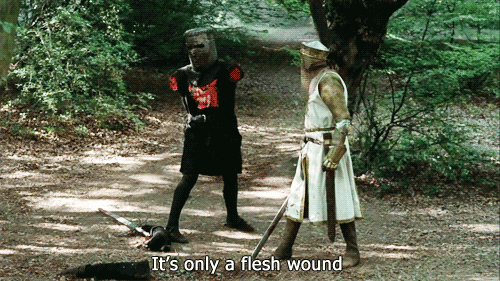Footage from Monty Python and the Holy Grail
Blood & Guts: In this model, hit points primarily represent actual physical harm suffered by a character. Fighters, barbarians, etc have more hit points than mages not just due to fitness but because they're overall portrayed as bigger and stronger. The fact that large monsters such as dragons and giants have greater-than-average amounts reinforces this paradigm. Even a large fellow with a high Strength but low Constitution might have a low pain threshold or be afflicted with ailments hindering their ability to fight.
Action Movie: In many shoot-em-up thrillers, it's common for the hero to get beaten up and bruised but manage to largely avoid grievous harm. Through a combination of quick reflexes, luck, and sheer willpower they push on through where most people would have given up and succumbed to pain and exhaustion. Even if the star of the show is supposedly a "normal person" in a world without superpowers, their very survival is nothing short of miraculous. In D&D games with this model, hit points represent not just the physical realm, but a combination of mental fortitude and lucky dodges. Losing hit points thus represents exhaustion and loss of focus as well as injury.
Sounds all well and good. Is there a problem?
Both structures have their place, but where it becomes problematic is when gaming groups and individual players develop different expectations. Such discussions are not unlike alignment debates and arguments in their passion. During the time of 4th Edition many folks thought that the idea of a Warlord "shouting wounds closed" was a ridiculous suspension of disbelief, when in reality the class' inspiring words restored the will to fight in their comrades so that they can press onward through the dungeon. A similar thing happened during the 5th Edition playtest, when Fighters had a feature which allowed them to still inflict some damage on a missed roll. Many gamers were so incensed at this that the moderators at EN World had to create a separate subforum solely dedicated to that class feature to act as a containment section. That way the complainers wouldn't restart the arguments anew in every single thread.
I think that the major problem is a lack of communication in game design on the part of the creators, and to a lesser extent the suspension of disbelief when it comes to non-magical classes and their healing capabilities. 1st Edition D&D is actually a good example on developer commentary helping inform the experience: Gygax explained that hit points were a combination of health, luck of the gods, willpower, and other factors. If it was solely relegated to physical injury and size, then a high-level Fighter would be able to suffer more blood loss than horses and ogres, which to him seemed silly and ridiculous. Compare this to 3rd Edition, which is more vague: "Hit points mean two things in the game world: the ability to take physical punishment and keep going, and the ability to turn a serious blow into a less serious one." The former part suggests the blood and guts routine with some willpower thrown in, although the latter can be reasonably interpreted either way. Is turning a blow into a less serious one represent half-dodging out of the way, or more akin to taking it but shrugging it off?
Does D&D better reflect one or the other?
That probably depends on the Edition, but in my views and experience I'm going to have to side with the action movie interpretation. Characters who gain levels aren't necessarily packing on additional mass every time they roll a Hit Die, and allowing for hit points to represent a variety of staying power fits better into the games with less house rules and complications. If hit points represented the sole province of injury and were presented as such in the game mechanics, then at some point they're going to cap for human-sized characters; one only has so many liters of blood and internal organs. Blood and guts can potentially be done, especially for grittier games, but it will take more work to implement.

It seems that Dave and Gary had a difference of opinion regarding what hit points represented. Gary's paragraph in the DMG was him defending his position on escalating hit points. Dave preferred that hit points remain the same and characters get harder to hit instead. Dave's rules (in Adventures in Fantasy) were much like Runequest in how they worked. By default they are based on the size of the creature, forex men had 10, elves had 8, but he had optional rules where your hit points where based on your stats (and, then reverse engineered to determine the character's size.)
ReplyDelete